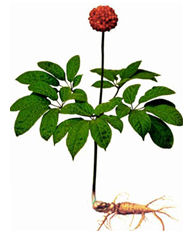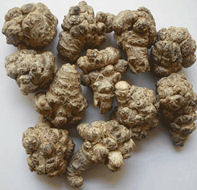Notoginseng
Panax Notoginseng is a species of the genus Panax. The scientific names for the plant commonly used are either Panax Notoginseng or Panax Pseudo Ginseng, and
is most commonly referred to as Notoginseng. The herb is also referred to as Pseudo Ginseng, and in Chinese it is called Tienchi ginseng, san qi or sanchi,
three-seven root, and mountain paint.
Notoginseng belongs to the same scientific genus as Asian ginseng; panax, araliaceae family. In Latin, the word panax means "cure-all", and the family of
real ginseng plants is one of the most well-known herbs. Panax Notoginseng is not an adaptogen like the better known Panax species, but it is famous as a
hemostatic herb.
Just like Panax ginseng, Panax quinquefolius and Panax vietnamensis, Panax Notoginseng contains the same dammarane-type ginsenosides as the major constituents
and are typically called; "Total Panax notoginsenosides" (TPNS) for Panax Notoginseng.
Dammarane type ginsenosides includes 2 classifications: the 20(S)-protopanaxadiol (ppd) and 20(S)-protopanaxatriol (ppt) classifications. Panax Notoginseng
contains high levels of Rb1, Rd (ppd classification) and Rg1 (ppt classification) ginsenosides. Rb1, Rd and Rg1 content of Panax Notoginseng is found to be
about as high as in Panax ginseng and Panax quinquefolius.
Panax Notoginseng is not used as a general energy tonic. While most real Ginsengs are deemed to be either yin or yang in action, Notoginseng is considered to
be neutral.
Introduction
Panax Notoginseng is a herbaceous plant. The root is used for different purposes. Be careful not to confuse Panax Notoginseng with other forms of ginseng, such as Panax CA Meijer or Panax quinquefolium.Panax Notoginseng is distributed in southwest China, mainly concentrated in the unique Panax Notoginseng planting region comprising the Wenshan Prefecture, Yunnan (Wenshan, Yanshan, Qiubei, Xichou, Guangnan and Maguan Counties) and the adjacent Youjiang River basin in the Guangxi Zhuang Autonomous Region (Jingxi, Debao and Napo Counties). It is also sparsely planted in some provinces south of the Yangtze River. In recent years, planting of Panax Notoginseng is also seen in the border areas between North Vietnam and China.
Panax Notoginseng grows naturally in China and Japan. The herb is a perennial with dark green leaves branching from a stem with a red cluster of berries in the middle. It is both cultivated and gathered from wild forests, with wild plants being the most valuable. The Chinese refer to it as "three-seven root" because the plant has three branches with seven leaves each. It is also said that the root should be harvested between three and seven years after planting it.

|
Photo: The whole plant of Panax Notoginseng |

|
Photo: Dried Panax Notoginseng roots |
Application
Legally, in Europe, Panax Notoginseng or its products are not mentioned in the EHIA Inventory List of Herbals and therefore not considered as Food.Panax Notoginseng food supplements were on market and consumed to a significant degree before 15 May 1997 and are therefore, according the EU Novel Food Regulation, only allowed to be used as or in food supplements and not in food.
Panax Notoginseng is not mentioned in the German Commission E Monographs.
Mainly the roots of Panax Notoginseng are used, but occasionally also the leaves as well as the flowers are used because of their beneficial effect on the vestibular system.
In TCM the Notoginseng Root is a favourite herb as it helps maintain a strong vessel wall and it enhances the skin's regenerative capacity.
Panax Notoginseng as a food supplement comes in a number of forms, including capsules, extracts, powders and tablets.
Panax Notoginseng has been considered "more valuable than gold" for thousands of years, and may be used as an adjunct to health diets to support of the immune system, heart and blood vessels and to the development of the brains.
Limited amount of cosmetic products containing Panax Notoginseng are available, such as creams, moisturizers and perfumes.
Panax Notoginseng is not mentioned in EU Decision 96/335/EG from EU Cosmetic Directive 76/768/EEG and/or 2006/257/EG.
Good for:
Notoginseng is an herb that has been used in China quite extensively since the end of the 19th century. It has acquired a reputation very favourable for the preservation of a strong vessel wall, promoting the absorption of iron in the blood and promoting the blood flow. It is the main ingredient in "Yunnan Bai Yao", a famous haemostatic patented herbal remedy mainly used by the Vietcong during the Vietnam War to treat wounds.Notoginseng has also been used in the United States for some years after childbirth and during menopause.
Panax Notoginseng has a nurturing effect on the cardiovascular system and contributes to the development of the brains.
It has a beneficial effect on the rough and chapped skin and enhances the regenerative capacity of the skin.
Notoginseng has a beneficial effect on the circulatory system and keeps a normal blood pressure.
According to the Dutch Guidelines KOAG / KAG allowable terms, related to this product, are:
- Provides good circulation and maintains a normal blood pressure.
- Helps lower cholesterol.
- Supports the healing ability of the skin.
- Strengthening the immune system.
- Keep the arteries clean.
- Improve the sperm mobility.
- Keeps the mind clear.
- Supports weight management
So far, the European Food Safety Authority (EFSA) has not approved any of the submitted health claims for this product or its components, and these should therefore not be used in the EU.


